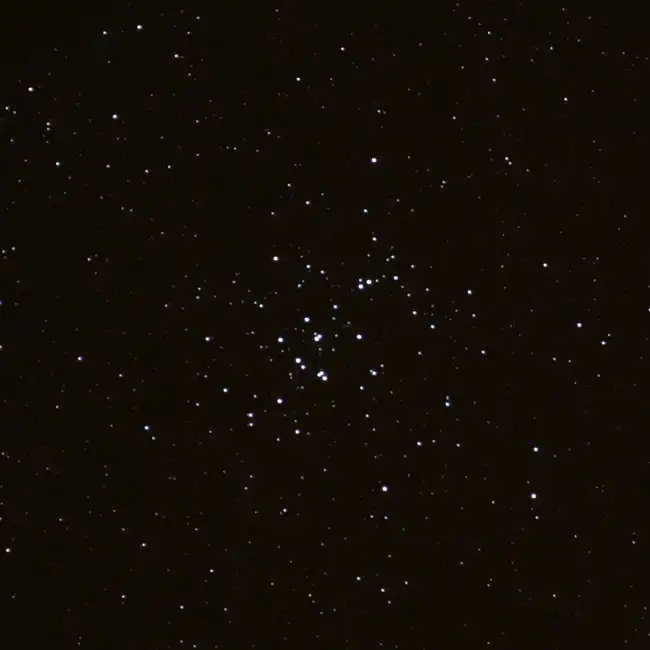Messier 44, commonly known as the Beehive Cluster or Praesepe, is one of the closest open clusters to Earth. It is an ancient star cluster located in the constellation Cancer, and its stars are spread out over an area about the size of three full moons in the night sky. The cluster contains a mix of bright and faint stars, with some of its most prominent members being giant stars that have evolved away from the main sequence. The Beehive Cluster is easily visible to the naked eye under dark skies and is best appreciated through binoculars or a small telescope, where the individual stars can be seen more clearly, resembling a swarm of bees, hence the name.
Magnitude
The Beehive Cluster has an apparent magnitude of 3.7, making it one of the brightest open clusters in the sky. Its stars are relatively spread out, but because of their collective brightness, the cluster is easily discernible. The brightest stars in the cluster are around magnitude 6.5, while the faintest stars visible in a telescope can go down to magnitude 11 or 12.

Prominent Season
Messier 44 is best observed during late winter and early spring in the Northern Hemisphere. The cluster reaches its highest point in the sky around March, making it an ideal target for stargazers during this time. Observers in the Southern Hemisphere can also enjoy views of the Beehive Cluster, although it will appear lower in the northern sky during the same season.
Constellation
Messier 44 is located in the constellation Cancer, the Crab. Cancer is a faint constellation, but it holds great significance in the zodiac as one of the twelve constellations that the Sun passes through each year. The Beehive Cluster is situated at the heart of Cancer, roughly midway between the stars Delta Cancri and Gamma Cancri.
How to Find Messier 44
To locate Messier 44, start by finding the constellation Cancer. This can be a challenge since Cancer is not very bright. However, the constellation lies between the more prominent constellations of Gemini and Leo, which can serve as guides.
- Locate Gemini: Look for the bright twin stars, Castor and Pollux, which form the heads of the twins in Gemini. They are relatively easy to spot.
- Locate Leo: Leo can be found by looking for the bright star Regulus, which marks the lion's heart. Leo’s Sickle asterism resembles a backward question mark or a sickle.
- Cancer’s Position: Between Gemini and Leo, you’ll find Cancer. It’s a faint constellation, so it’s best to use a star chart or an app to pinpoint its location.
- Finding M44: Once you’ve found Cancer, look for the midpoint between the stars Delta Cancri and Gamma Cancri. The Beehive Cluster lies almost exactly in the middle. It’s visible to the naked eye as a faint, hazy patch, but through binoculars or a telescope, it resolves into dozens of stars.

History
The Beehive Cluster has been known since ancient times. The earliest recorded observation dates back to at least 260 BCE by the Greek astronomer Aratus, who mentioned it in his work “Phenomena” as a "little mist." Claudius Ptolemy, in the 2nd century, listed it as one of the "nebulous" objects in his Almagest, referring to it as "the nebulous mass in the breast of Cancer."
The cluster was later cataloged by Charles Messier in 1769 as the 44th entry in his famous catalog of deep-sky objects. Messier, a French astronomer, created this catalog to help astronomers distinguish between fixed objects like star clusters and nebulas and the transient objects like comets, which were the primary focus of his work.
The Beehive Cluster’s historical significance is also noted in its Latin name, "Praesepe," which means "manger." In medieval times, the cluster was associated with a manger flanked by two donkeys, represented by the nearby stars Asellus Borealis and Asellus Australis, which are also in the constellation Cancer.
Conclusion
Messier 44, the Beehive Cluster, is one of the most beautiful and accessible open clusters in the night sky. Its ancient stars, visible in all but the most light-polluted skies, offer a glimpse into the stellar nurseries that have populated our galaxy for billions of years. Observing the Beehive Cluster provides both a challenge and a reward, connecting us to the same view of the cosmos that has fascinated humanity for millennia. Whether you’re using a small telescope, binoculars, or simply your eyes, M44 is a must-see for any stargazer.
